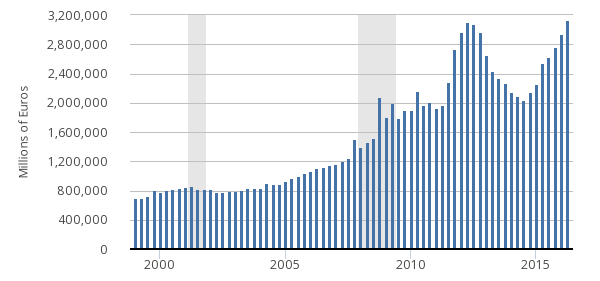The European Central Bank Is Close to Committing Suicide – Here’s Why

Central banks appear to compete over having the largest balance sheet in the world. Past month, the European Central Bank (ECB) had the dubious honor of breaking its own previous high. The ECB crossed the €3,130 billion-mark in total assets. In June alone, the central bank grew its balance sheet another €53 billion.
But the ECB is running into its limits. Last year, I raised the possibility that the ECB’s stimulus program might end prematurely. There are simply not enough eligible government bonds for the ECB to purchase. So I concluded that “the ECB has no other choice than extending its purchases to other assets than government bonds, with all the (political) consequences this would entail.” In March, ECB-chairman Mario Draghi reached the same conclusion. He announced that the ECB would also begin purchasing corporate debt. But that does not help the ECB from getting dangerously close to derailing itself and losing complete credibility.

Total ECB assets just reached record highs. Source: St Louis Fed, European Central Bank
Central Banks Are Not Almighty
It is an illusion that central banks have a “bottomless” wallet at their disposal, a metaphorical credit card without any spending limit. Central banks appear to be almighty. But their power is rather limited. For starters, a central bank is merely capable of creating bank reserves and only by buying assets from its member banks or other financial institutions.
In other words, there is a natural limit to a central bank’s almightiness. A central bank is powerless when there are no assets left to buy, when there is no “eligible collateral.” And by buying increasingly risky assets, or expanding the “eligibility” of the collateral it is willing to accept, a central bank distorts markets.
A simple thought-experiment shows how central banks distort markets. If central banks would own 100% of bond markets, no price formation would occur. Whenever a central bank approaches this imaginary state, it impairs price formation. The bigger its share, the worse the distortions.
And even when a central bank does not own the entire 100% of outstanding bonds, the consequences are dire. The “free float” diminishes, causing wild fluctuations in bond prices and increases in volatility on a scale never seen before. “Free float” indicates the percentage of bonds that are actively traded. In a sense, when central banks buy bonds, they withdraw them from the market. The fewer bonds remain, or the lower the “free float”, the wilder their price fluctuations.
Ironically, There Is Not Enough Eligible Government Debt for ECB’s Purchase Program
In 2015 ECB-chairman Mario Draghi promised markets to buy €1,140 billion of government debt. His announcement shook financial markets as the size of this massive purchase program was something never seen before.
However, the purchase program entailed some restrictions:
- Of every new issue the ECB is only allowed to buy up to 20%
- The ECB may hold a maximum of 33% of outstanding government debt of any given country
- The ECB is not allowed to purchase government bonds with yields lower than the ECB deposit rate (currently at -0.4%)
In 2015, I said that the ECB purchase program would end prematurely, unless they would expand the assets they purchase from government bonds to other assets. In March, Mario Draghi admitted that the ECB would begin to purchase corporate bonds.
Since then, some things have changed. Bond investors, in what seems like speculative fever reminiscent of the worst financial bubbles in history, have started to front-run the ECB. In anticipation of further ECB easing, bond investors desperately try to beat the ECB to the punch.
Let’s take Germany as an example. Germany has issued a total of $1,131.9 billion in bonds. Already $801.4 billion has a yield lower than the current ECB deposit rate (that is, lower than -0.4%), which amounts to 71 percent. The ECB already holds about 20% of German public debt.
A quick and dirty calculation shows that only a few months of German government bond purchases remain before the ECB’s purchase program is running into its limits. As soon as in September, Draghi will have to face this pressing issue.
What options does he have? (1) Lower the ECB deposit rate, (2) start purchasing other assets, (3) start buying debt from “higher interest rate countries” (for instance Italy) in greater proportions than “lower interest rate countries” (for instance Germany), and/or (4) allowing the ECB to buy government debt even if yields fall below the ECB deposit rate.
The ECB’s Adventure in Europe’s Corporate Bond Market Will End Badly
While Mario Draghi announced in March that the ECB would start purchasing corporate bonds and extend its quantitative easing program, it in fact only began purchasing corporate bonds as of last month.
The ECB’s intervention was directly felt. CNBC reported that “nearly 19 percent of all corporate bond activity in the past two days is down to the ECB’s corporate bond-buying program.” This means that there is a 19% increase in demand for corporate bonds from a buyer that has no clue whatsoever whether it is appropriate to buy a given bond of a given counterparty against a given price and, moreover, has nothing to lose in its speculative endeavors. The ECB is like a gambler at the roulettes of a casino with a no-loss guarantee.
In less than three weeks the ECB has soaked up nearly €5 billion of corporate bonds. That is 1% of the entire European corporate bond market. In three weeks.
The problem, of course, is that the European corporate bond market is small. In contrast to the United States, European companies are mainly financed through bank credit, not through bond issuing. That means that extending the ECB purchase program from government bonds to corporate bonds will not make a big difference. It will buy the ECB a few more months before it reaches its limits, that is, before it soaks up all eligible collateral. It merely postpones the problem, and not for long.
Moreover, the size of the corporate bond market varies between Eurozone countries. The Dutch corporate bond market, for instance, represents 26% of the entire European corporate bond market, a disproportionate share for such a small country. The German bond market is much smaller. The fact that the ECB’s purchases of corporate bonds favor some countries disproportionately, might cause political friction in the future. France also benefits disproportionately, at the cost of Germany and other countries.
Yet the ECB’s corporate bond purchases have other unintended consequences. What is the natural reactions of markets when the ECB starts buying indiscriminately corporate debt? Right. Issue corporate debt. And lots of it.
After Mario Draghi announced that the ECB would begin purchasing corporate bonds in March, weekly corporate bond issues reached record highs in both April and May: €21.7 billion and €19.7 billion was raised. In other words, the ECB creates an enormous moral hazard, luring companies into issuing bonds. The ECB finances a house of cards and that house of cards has only one possible outcome: collapse.
Further Interest Rate Cuts Inevitable
A further rate cut in the ECB deposit rate is to be expected at the next ECB-meeting on Thursday July 21. Above all to make sure that the pool of eligible bonds increases somewhat. However, with front-running at its fullest, a rate cut will be nothing more than a temporary relief for the monetary cranks at the ECB.
On the other side of the world, in Japan, the situation is not much better. The Bank of Japan already holds more than 30% of all Japanese government bonds and is forecasted to reach 50% in 2019. It will be a race to the bottom to see which central bank will reach its natural limits first: the ECB or the BoJ.
Volatility in bond prices will go through the roof because of central bank intervention, as we have seen. In a few years, when we look back on the current period, we will undoubtedly come to the conclusion that the current paradigm failed. Mario Draghi, most likely, will be retired by then. His term will end in 2019. He has every reason to kick the can down the road as far as he can.
Meanwhile, whoever thinks government bonds are a smart investment either suffers from a gambling addiction or fails to understand the role of today’s central banks.
Get our free exclusive report on our unique methodology to predict recessions

Olav Dirkmaat
Olav Dirkmaat is professor in economics at the Business School of Universidad Francisco Marroquín. Before, he was VP at Nxchange and precious metals analyst at GoldRepublic. He has a PhD in Economics from the King Juan Carlos University in Madrid. He has a master in Austrian Economics from the same university, as well as a master in Marketing Strategy from the VU University in Amsterdam. He is also the translator of Human Action of Ludwig von Mises into Dutch. He has a passion for investing, and manages funds for relatives, looking for investment opportunities in markets that are extremely over- or undervalued.
Get our free exclusive report on our unique methodology to predict recessions



You claim the ECB is running into it’s limits, are these absolute limits of debt they can hold? what are the limits and how are they calculated?
Interesting comments on the German sovereign market, has the ECB has already reached the 33% limit on other countries, specifically Greece, Spain and Italy? Is there any constraint on changing that limit?
If the bond market response to the ECB programme is to issue more debt, then isn’t that exactly what the ECB sought to achieve?